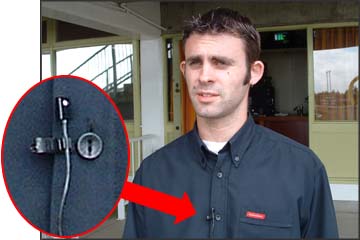Recording Sound for Interviews
Sound quality is especially important in interviews. The audience will be concentrating more on what the guest is saying than how they look. Without crystal clear sound your interview will be irritating to viewers.
Microphones
The first decision is which type of microphone best suits your situation.
Hand-Held Mics
Hand-held mics are versatile and relatively easy to use. They are well-suited to mobile interviews, and to situations where the interviewer needs to direct the talking (people can only speak when the interviewer points the mic at them). For more information, see How to Use a Hand Mic.

Lapel Mics
Lapel (lavalier) mics create high quality, consistent sound. Each person has their own mic, the mics are (theoretically) always in the correct position and unwanted noise is rejected well.
The disadvantage is that they are slower and more difficult to set up, especially if there are a number of guests coming in and out of the IV setting. Also, if the mic position does happen to go awry, you have to interrupt the interview to fix it.
Boom Mics

Microphones placed on a boom arm are also very versatile and are used in both studio and mobile settings. The main advantage is that the IV participants don't need to be rigged for audio or worry about mics, and the sound operator is in full control. The microphone is usually a shotgun (very directional) mic which can easily be pointed to any speaker (or other sound if required).
The boom operator and camera operator need to work together to make sure the mic stays out of camera shot.
PZM (Pressure Zone) Mics
PZM mics are useful when a number of participants are seated around a table. The mic is placed in the middle of the table and can pick up all speakers.
Radio Mics
Any type of microphone can be plugged into a small battery-powered radio transmitter and sent to a receiver at the recording end. This frees the interviewer and guest from the restraints of audio cables. It also means the participants can be a long way from the camera (which would obviously be on a long zoom).
Built-in Camera Mic
If you're desperate you can use the mic which is built into the camera. However this is unlikely to produce good interview sound.
Mixing and Recording
In the studio, mics will be routed to the sound desk and mixed into the program audio by the sound operator.

In mobile interviews, the ideal situation is to have a dedicated sound operator ("soundie"). The soundie will plug the mics into a portable sound mixer like the one pictured and monitor the audio via a headset. The output of the mixer will either be fed to a portable recording device or (more commonly) fed to the camera and recorded on the same tape as the vision.
Audio Traps to Avoid
- Many people begin their sentences loudly then tail off. You may need to compensate.
- Beware microphone handling noise, especially with cheap mics and inexperienced presenters.
- If wind is a problem, use a sock or (preferably) shield the mic.
- Background music means death in the edit suite. Turn any background music off.
For more details about microphones, see How Microphones Work. For more information about sound, see our Audio Tutorials.
Next Page: Interview Lighting